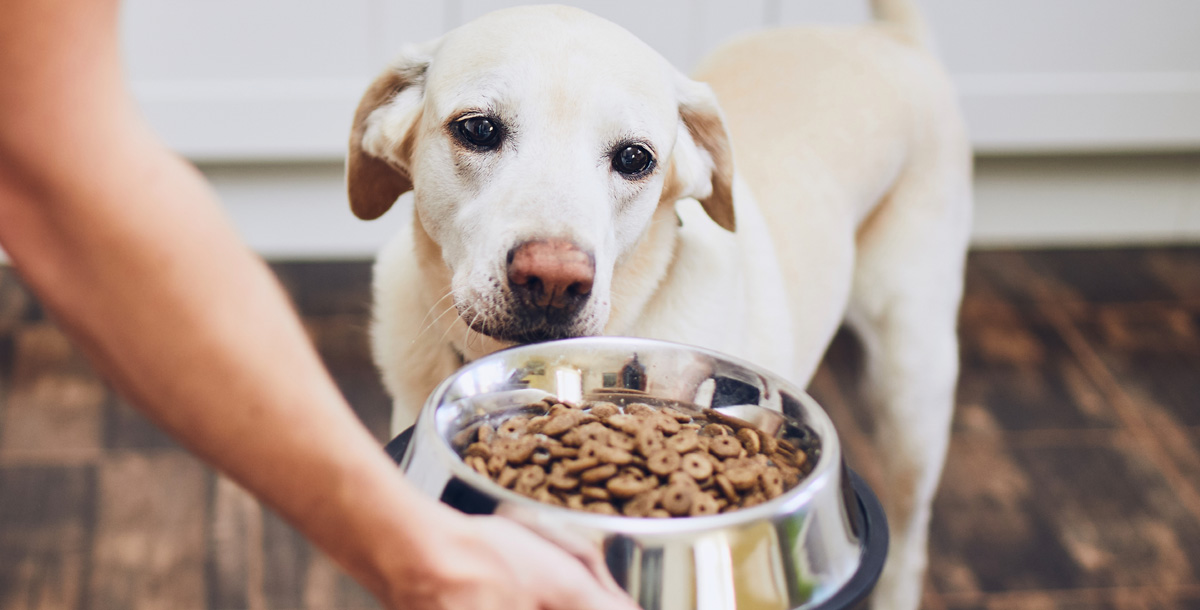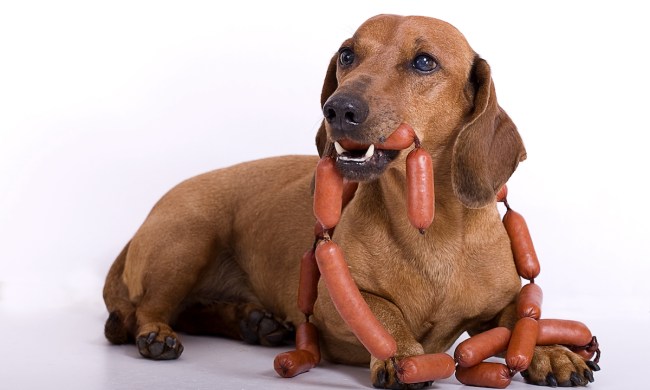Walk down the food aisle of any pet store, and it’s enough to make your head spin. There are so many choices, it’s hard to know which food is best for your dog. When looking at ingredients, many pet owners don’t consider fiber, but it has important health benefits. High-fiber dog food typically has at least 6% fiber and ingredients that may include a selection of fruit and vegetables in addition to whole grains, brown rice, and oatmeal.
According to veterinarian Shawn Messonnier in an Animal Wellness magazine article, fiber encourages normal bowel movements, helps prevent overeating and obesity, and can also improve blood sugar control and stabilize a dog’s cholesterol levels. The best high-fiber dog food will also be high in protein and include vitamin-rich ingredients, providing your dog with a well-balanced, healthy diet.

According to veterinary experts at Tufts University Cummings School of Veterinary Medicine, the amount of fiber in different brands of dog food varies dramatically from one to another. Diets marketed for weight control are more likely to be relatively high in fiber. Keep in mind that while some dogs can tolerate different types and amounts of fiber, for others it may take some trial and error to find a diet that produces the ideal stool quality. If your dog tends to have diarrhea, suffers from constipation, or has diabetes or high blood fats, you should consult with a veterinary nutritionist for guidance on the best diet for him, Tufts University experts say.
The best high-quality high-fiber dog foods for under $65
Here’s a roundup of the best high-fiber food for dogs. None of these recipes contain artificial flavors, colors, or preservatives, and all are among the top-rated brands on Chewy, Amazon, or Petco.
Taste of the Wild High Prairie Grain-Free
This dry dog food includes bison and venison as the first ingredients and is high in protein. It also includes tomatoes, blueberries, and raspberries, providing fiber and antioxidants in addition to vitamins C and E and magnesium. One Chewy reviewer feeds this brand to her four dogs because it has “minimal ingredients, good protein, and no harmful products” and they all “love it.” This diet is made without grains, corn, or wheat.
Blue Buffalo Wilderness Healthy Weight with Chicken Recipe
The first ingredient in this food is chicken. It also contains blueberries, cranberries, and carrots, all providing beneficial nutrients and fiber. In addition, the food includes glucosamine and chondroitin for joint health. A Chewy reviewer reports that her 8-year-old dog who has to be on grain-free food for weight control “absolutely loves” this food and her coat “looks great.”
IAMS Adult MiniChunks Small Kibble
This food provides a healthy source of protein from farm-raised chicken and also contains a blend of wholesome grains, carrots, and beet pulp for healthy digestion. In addition, it contains antioxidants to help support your dog’s immune system. A pet parent on Amazon reports that her golden retriever “is still in great shape after 14 years because of this dog food. He looks and acts half his age.”
Wellness Complete Health Deboned Chicken and Oatmeal Recipe
The high-quality ingredients in this diet include premium chicken, whole grains, carrots, spinach, and blueberries as well as omega fatty acids, antioxidants, glucosamine, probiotics, and taurine. It’s designed to boost a dog’s energy level, aid overall digestion, and help keep your dog’s skin and coat healthy. A pet parent who reviewed the food on Chewy says that the family’s young black Labrador mix “has a healthy bowel movement on this diet and is growing beautifully.”
Merrick Grain-Free Healthy Weight Recipe
This is a great high-fiber choice for overweight dogs. The first ingredient is deboned beef and the food includes sweet potatoes, apples, peas, blueberries, and flaxseeds, all healthy sources of fiber. Additionally, it contains omega fatty acids to benefit the skin and coat along with glucosamine and chondroitin for hip and joint health. A Petco reviewer whose dog, Luna, has always been on this diet says that she loves the food because “it smells super fresh” and “keeps Luna’s poop consistent.”
Canidae Pure Healthy Weight Real Chicken and Pea Recipe
This is another good choice for weight watchers. The first ingredient is chicken, providing a good source of protein. Other ingredients include high-fiber foods such as sweet potatoes, peas, chickpeas, and alfalfa. The recipe also includes a blend of probiotics, antioxidants, and omega-3 and -6 fatty acids. One Amazon reviewer who feeds this brand to her two Staffordshire bull terriers reports that after taking a nutrition class, she researched different dog foods and found that “Canidae out beats most of them by a landslide.”

Feed your pet the best possible diet
When choosing a diet, remember that dogs are individuals and their dietary needs will depend on their age, health, and personal preferences. If your dog tends to have diarrhea or suffer from constipation or has diabetes or high blood fats, you should consult with a veterinary nutritionist for advice on the best diet for your pup, according to Tufts University experts. If you’re planning to change your dog to a high-fiber diet, do your research, choose the food you think would work best for your dog, and then get your vet’s input. And when you’re finally ready to make the change, it needs to be done slowly by mixing the new food with the old to give your dog’s system a chance to adjust to the new diet.



